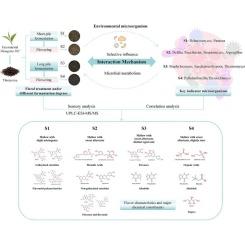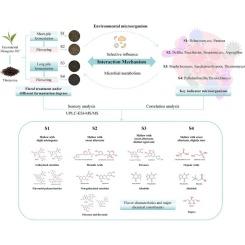IF 9.8
1区 农林科学
Q1 CHEMISTRY, APPLIED
引用次数: 0
摘要
黑茶是一种传统的后发酵茶,通过微生物发酵产生独特的风味和健康益处。使用感官评价、广泛靶向代谢组学、16S/ITS测序和WGCNA对4个样本进行评估。结果表明,“开花”调节了关键的微生物类群(如异核曲霉、普鲁兰杆菌),改变了多酚降解和氨基酸谱,并形成了包括回归甜味、酸味和陈年香气在内的感官性状。在轻度发酵的茶中,“开花”丰富了链霉菌和代尔夫特菌,帮助曲霉菌占优势,减少了苦味。在深度发酵茶中,长时间的潮湿条件有利于耐热真菌和有机酸的积累。本文章由计算机程序翻译,如有差异,请以英文原文为准。


Multi-omics network analysis of flavour formation in golden-flowered Tibetan dark tea processed by “flowering” using raw materials with different fermentation degrees
Dark tea, a traditional post-fermented tea, develops distinct flavour and health benefits through microbial fermentation. The “flowering” process, marked by golden fungal growth, is well-studied in Fu-brick tea but underexplored in Tibetan dark tea. This study investigated how “flowering” affects flavour, chemistry, and microbiota in Tibetan dark teas of varying fermentation degrees. Four samples were assessed using sensory evaluation, widely-targeted metabolomics, 16S/ITS sequencing, and WGCNA. Results showed that “flowering” modulated key microbial taxa (e.g., Aspergillus heterocaryoticus, Pullulanibacillus), altered polyphenol degradation and amino acid profiles, and shaped sensory traits including returning sweetness, sourness, and aged aroma. In lightly fermented tea, “flowering” enriched Streptomyces and Delftia, aiding Aspergillus dominance and reducing bitterness. In deeply fermented tea, prolonged humid conditions favored thermotolerant fungi and organic acid accumulation. A substrate–microbiota–metabolite–sensory network was established, offering insights for targeted modulation of flavour in golden-flowered Tibetan dark tea.
求助全文
通过发布文献求助,成功后即可免费获取论文全文。
去求助
来源期刊

Food Chemistry
工程技术-食品科技
CiteScore
16.30
自引率
10.20%
发文量
3130
审稿时长
122 days
期刊介绍:
Food Chemistry publishes original research papers dealing with the advancement of the chemistry and biochemistry of foods or the analytical methods/ approach used. All papers should focus on the novelty of the research carried out.
 求助内容:
求助内容: 应助结果提醒方式:
应助结果提醒方式:


